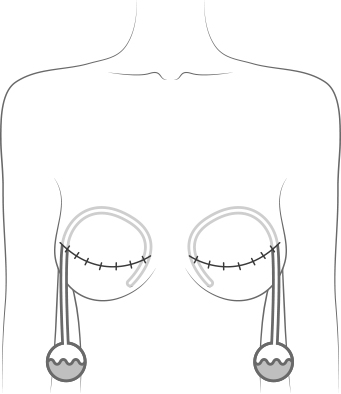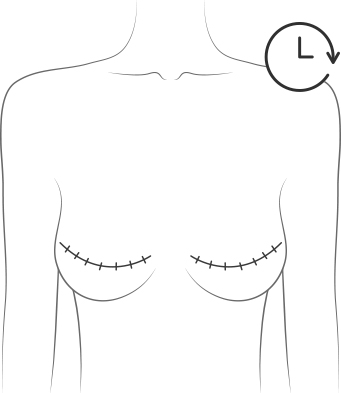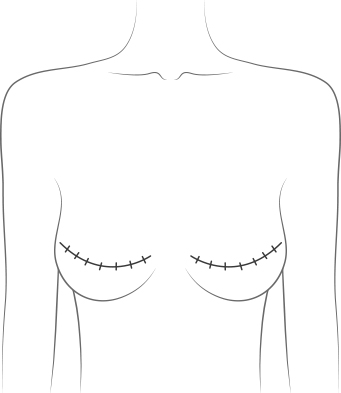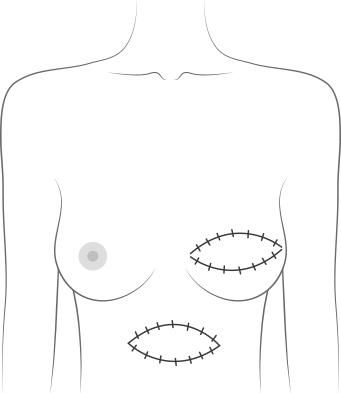By continuing to use our site, you consent to the processing of cookies, user data (location information, type and version of the OS, the type and version of the browser, the type of device and the resolution of its screen, the source of where the user came from, from which site or for what advertisement, language OS and Browser, which pages are opened and to which buttons the user presses, ip-address) for the purpose of site functioning, retargeting and statistical surveys and reviews. If you do not want your data to be processed, please leave the site.
The Voice of People With Breast Cancer
helping you understand your surgical options
SurgeryGuide
Jump to:
Breast Reconstruction
Breast reconstruction is a surgery, or surgeries, performed after a mastectomy to rebuild the breast(s). The decision to have breast reconstruction is a very personal choice, and each woman has her own particular reasons as to why she does or does not choose this option. If you feel uncomfortable with your mastectomy scar, you don’t want to live flat or asymmetrical, or you feel that a prosthetic would be uncomfortable, you may want to consider reconstruction. Perhaps you want to return to something near your original physical appearance. You will want to look at whatever will give you increased self-confidence. These are things to keep in mind when you are making your decision.
The availability of plastic surgeons who are trained in the specific breast reconstruction technique you prefer may vary depending on where you live. Speak with your surgeon to understand what options are available to you that best meet your needs.
Immediate vs. Delayed Reconstruction
Immediate Reconstruction

Breast reconstruction performed immediately after your mastectomy
- This reduces the need for multiple surgeries; however if you’re having expanders put in then you will still need an additional surgery to change the expander to an implant
- Often the cosmetic results are better
- Can be a psychological advantage to having reconstruction immediately after a mastectomy
- It’s a longer surgery than doing them as two separate surgeries
- Longer recovery time than just having a mastectomy
- May be challenging to coordinate having the surgical oncologist and plastic surgeon available at the same time
Delayed Reconstruction

Breast reconstruction done months or years after your mastectomy, there is no time limit on getting reconstruction after a mastectomy
- May be medically necessary if additional treatment, such as radiation, is required after a mastectomy
- Allows more time to research reconstruction options
- Allows you to focus on cancer treatments and make reconstruction decisions at a different date
- Additional surgeries are required if you delay reconstruction and wish to have reconstruction in the future
- Cosmetic results may not be as good as immediate reconstruction

“I chose to have the immediate reconstruction at the same time as my mastectomies. This decision was obviously a personal one and required in depth consultation with both my general and plastic surgeons. It was a great decision as I had one recovery, one procedure and I did not have the feeling of loss that I have heard a lot of patients feel after mastectomy surgery. I felt that I was young, healthy and mentally strong enough to handle the procedure and recovery which is very important when making this decision.”
~Cathy~

“I wasn’t offered immediate reconstruction after my mastectomy because I received neoadjuvant chemotherapy; which means that I had chemo first and then surgery. My medical team also didn’t want to see any reconstruction work that I had done to be potentially damaged by radiation. As it turns out I didn’t need radiation and therefore I would have been a candidate for immediate reconstruction. Sometimes I wish that I would have been able to have my mastectomy and reconstruction done at the same time. But I have now come to terms with the fact that delayed reconstruction has allowed me to be emotionally and physically prepared”
~Trisha~

“I had a lumpectomy and was told I would need radiation; however, when I didn't get clear margins I requested a mastectomy and my general surgeon offered an immediate breast reconstruction since they felt I would not need radiation or chemotherapy. The term "immediate " in my case turned out to be anything but immediate - the tissue expander did not stretch my skin as had hoped so I needed a Latissmus dorsi flap procedure.”
~Susan~
- Research: Immediate vs. Delayed reconstruction & risk of recurrence
-
Studies have shown in women who had immediate reconstruction or delayed reconstruction, the risk of recurrence remained the same. Read the research here.
Types of Breast Reconstruction
There are three types of breast reconstruction that are available; autologous reconstruction, implant based reconstruction and hybrid reconstruction.
-
Autologous Reconstruction
Autologous Reconstruction is when tissue is used from other parts of the body to reconstruct the breast. Most of tissue comes from belly, buttocks, inner thighs or back. Tissues can either remain attached to their original blood vessels and moved under the skin to the chest, which is called a “pedicle flap”. Tissues can also be detached from the blood vessels and the moved to your chest, which is called a “free flap”. Free flap requires the surgeon to attach new blood vessels from the chest to the tissue flap to blood vessels in ensuring that the tissue gets enough blood.
Considerations
- Softer more realistic feeling breast because it’s made of human tissue
- No maintenance required over time
- No additional surgeries once desired results have been achieved
- Longer surgery with longer recovery time
- Scars on other locations on your body where the tissue was taken from which also impacts recovery time
- Must have sufficient excess fatty tissue at other locations of your body to be moved to your chest to recreate breast(s) of desired size
-
Implant Based Reconstruction
Implant based reconstruction uses a silicone shell filled with saline (salt water), silicone gel, or a combination of the two to rebuild the breast. If you’re having implant reconstruction immediately after your mastectomy and there is enough skin tissue left after the surgery, the implant can be directly inserted below the chest muscle at that time.
Tissue Expanders
If you’ve had a large amount of skin removed, or if you are having delayed reconstruction, a tissue expander will be inserted behind the chest muscle. The tissue expander is used to help stretch your skin and chest tissue to make enough space for the implant. Over the next couple of months your doctor will slowly fill up the tissue expander with saline. They will do this by injecting the saline with a needle through a valve that is just under the skin. Usually there is no sensation in the skin of the mastectomy scar so you should not feel the needle. Once the tissue has been expanded enough you will undergo another surgery to remove the expanders and have the implant inserted.
There are now some tissue expanders that are designed to be expanders and implants in one. Once they are filled to the desired size they are left in place, which reduces the need for a second surgery. They are associated with a high complication rate so may not necessarily be offered by your surgeon.Considerations
- Shorter surgery time and shorter recovery time than autologous reconstruction
- No incisions and scars on other parts of the body from donor tissue sites
- Good option for smaller women who may not have as much fatty tissue to help rebuild a breast
- Implants only last for 10-20 years so you will probably need to have another surgery to replace them later
- Will not feel as soft or realistic as human tissue
- Some patients may have difficulty expanding the skin after radiation due to lots of scarring
Concerned about texture implants? Read our blog post on the subject.

“I am in the middle of implant-based reconstruction. So far it all has been an exciting experience for me. The new look of my breasts is amazing, and I can’t wait to see the finished result. I have decided on round silicone implants, and I am working closely with my plastic surgeon to ensure that they look the way that I want them to. I know that the implants will never be the same as my real breasts, but to me reconstruction is getting back a piece of what cancer took away”
~Trisha~
“With respect to implant-based reconstruction that requires the use of expanders, I wish I had been warned as to how uncomfortable the expanders were as they are filled over time. Because the second stage of the surgery (to remove the expanders and replace them with the implants) is not considered “cancer” surgery but rather cosmetic surgery, the patient is forced to wait in line so to speak. In my case, my mastectomies and first stage reconstruction were in April 2009 and I did not have the expanders replaced until June 2010. The expanders, once filled, feel like rocks and it is impossible to hug anyone, let alone sleep on your stomach.”
~Karen~
“Now almost 9 years later, it is almost time to replace the original implants. I am prepared to undergo surgery once more but doubt, if I am alive at the age of 73, that I would do it then. At that point, I think I will be prepared to live flat or use a prosthetic. This is a downside to the implant-based reconstruction. The older I get, the more grateful I am to be alive and the less willing I am to undergo surgery for cosmetic reasons.”
~Karen~ “I had a unilateral mastectomy with immediate reconstruction. I had a tissue expander put in and then 6 months later I had the expander exchanged for a silicone implant. At the time of the exchange surgery, I also had the other breast augmented to try to match the new breast in terms of its shape and size. I also had fat grafting done to make my new breast look more natural. I knew this would be the process.
“I had a unilateral mastectomy with immediate reconstruction. I had a tissue expander put in and then 6 months later I had the expander exchanged for a silicone implant. At the time of the exchange surgery, I also had the other breast augmented to try to match the new breast in terms of its shape and size. I also had fat grafting done to make my new breast look more natural. I knew this would be the process.Overall I am happy with the results. However, what I wish I had known was that it takes time for everything to settle so the breasts may not initially be symmetrical and matching (I was initially so disappointed at how I looked but then the surgeon told me that they sat me up during surgery to make sure everything matches and that it will take a few months for things to settle - anyways, it would have been nice to know all this before the surgery).
Also, with fat grafting, I was left with a huge black bruise on the back of my upper leg (where they took the fat from) that took 4 months to resolve. I couldn't sit on the toilet for a few weeks! Turns out when the fat is too close to the muscle, fat grafting can injure the muscle and cause hematoma that takes forever to go away. Even though we all think we have plenty of fat, it may not be enough for fat grafting. I have rippling in my implant and my surgeon doesn't want to do any more fat grafting unless I gain 10lbs.
I also have a lot of upper back pain since the exchange surgery. It's been 6 months and I am still in physio. But overall I am happy with the results. Everything looks better now, the breasts match, I can even go without a bra and they still match, and fake breasts look great in a bikini!”
~Maja~ -
Hybrid Breast Reconstruction
This combines using tissue from other parts of your body as well as a small breast implant. This is usually done when there isn’t enough tissue that can be taken from another part of the body to get the desired shape and size for the new breast. This procedure introduces risks from both procedures which is an important consideration to discuss with your surgeon.
Something to consider…Nipple and Areola Reconstruction
The decision does not have to be made upfront whether or not to reconstruct the nipple, it may be completed years down the road. At a very minimum the initial mastectomy surgery must be fully healed before a surgeon will consider nipple reconstruction surgery.The decision to have this portion completed as a final step in the overall recovery process is also a personal preference. It is not required in any way medically but may provide breast cancer patients a benefit in the mental health aspect of the recovery.
There are two main options available for women who chose to have their breast reconstruction include the nipple replacement step:
Nipple Reconstruction
- The surgeon may take tissue from another part of your body to rebuild the nipple
- The nipple may also be recreated by "pinching" or "twisting up" any excess skin on the chest in the area of where the new nipple will be to recreate the nipple mound
- A tiny incision is made and the surgeon reconstructs the illusion of a nipple from your own tissue, usually surrounding tissue
- Short healing and recovery time
- Will not have the pigmentation of a real nipple or areola
Nipple Tattooing (micropigmentation)
- A tattoo artist or plastic surgeon tattoos a nipple and areola in place
- One option is a tattoo that is mere shadowing and coloring in the general area of where the nipple should be located.
- The second option is a 3D version of a nipple tattoo that is more characteristic and life like. The tattoo is completed in 2 phases (more if need be) to create the detail, colouring and specific characteristics of a real nipple.
- Less invasive that reconstruction
“Getting the nipple tattoo's was great. Very professional lady that put me at ease and was able to choose the right areola shade. Due to the flap surgery, the skin is numb so when the tattoo is being put on, you feel nothing. It doesn't take long and the results were amazing. I would highly recommend this. The price was less than $400.00 too.”
~Cheryl~






